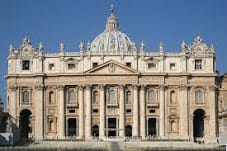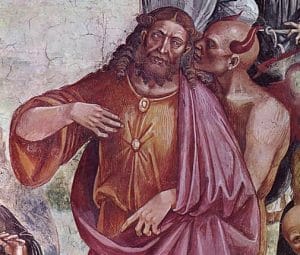Although it is not clear who first pointed this out, it is most certainly true that there is a certain law of undulation at play in every time and every culture related to the quality of the men: “Hard times create strong men. Strong men create good times. Good times create weak men. And, weak men create hard times.” We are, by almost any accounting, living in hard times, plagued by weak men. Historically speaking it is hard to say how long the hard times must go on before the strong men emerge, but there is a growing awareness among many men in our culture that something is amiss with manhood. This awareness helps to explain the growing popularity of Stoicism, especially among young Catholic men. Because of Stoicism’s emphasis on virtue, most assume that Stoicism and Catholicism are compatible. It is worthwhile then to examine whether this is true.
Sitting on the Porch
Stoicism has a long history that extends back to ancient Greece and the lectures that Zeno of Citium gave to his students on his porch or stoa. It lay mostly dormant until around the 1st Century AD when it was revived by Epictetus and Seneca, followed by the first philosopher king, Marcus Aurelius. It is marketed as a practical philosophy (i.e. ethics) based on the pursuit of virtue. According to Epictetus this pursuit is governed by two principles. First, “In life our first job is this, to divide and distinguish things into two categories: externals I cannot control, but the choices I make with regard to them I do control. Where will I find good and bad? In me, in my choice.” This dichotomy of control is supplemented by a second principle aimed at our response. “What hurts this man is not the occurrence itself…but the view he chooses to take of it.” Essentially this means that there is nothing good or bad in itself, only our attitude towards it gives it an ethical color. We have the opportunity to see everything that happens as a means grow virtue. Although it is often described as such, Stoicism is also not an emotionless ethic. Because of its emphasis on virtue, it is about bringing our emotions under the control of reason.
It is ultimately this pathway to an inner freedom that comes about by focusing only on those things that we can control that makes it appealing to modern men. The hard times make the battlefield seem so large and many men struggle to pick their battles and end up in a holding pattern. But there is more to Stoicism than just this. Stoicism ultimately is a pantheistic religion. The reason why the Stoic can practice the necessary detachment is because he believes that everything that happens is necessary and good serving the Good of the whole. There are no physical evils and the only moral evil is personal vice and folly.
Ideas Have Consequences
That I labeled Stoicism as a pantheistic religion anticipates the fact that it is not wholly compatible with Catholicism. But in truth, the two cannot be reconciled at all. Its insistence that it is only our reaction to what happens that makes something good or evil leads to a subtle form of moral subjectivism. There are many evils in the world that we cannot control and yet we must offer resistance or even fight against. Detachment to things we cannot control is great until we are confronted with the suffering of another person. Their suffering is only because they are thinking about it wrongly and thus empathy and compassion are folly. Epictetus unashamedly counsels a fake compassion when he says,
“When you see a person weeping in sorrow, either when a child goes abroad, or when he is dead, or when the man has lost his property, take care that the appearance do not hurry you away with it as if he were suffering in external things. But straightway make a distinction in your mind, and be in readiness to say, it is not that which has happened that afflicts this man, for it does not afflict another, but it is the opinion about this thing which afflicts the man. So far as words, then, do not be unwilling to show him sympathy, and even if it happens so, to lament with him. But take care that you do not lament internally also.”
This fits with my experience with many men who practice Stoicism, Christian or not—they are usually the most judgmental and disinterested especially towards those who they deem not as strong-willed as themselves.

This brings up a necessary, although slightly tangential point. The reason the Church maintained the Index of Forbidden Books for so long was not just to protect the Faithful from heresies. There is a very real way in which false teachers of religion and philosophy can put an enchantment on the reader. They have a tendency to draw the reader in and make him question reality, even when he is only curious or trying to adopt certain aspects of that philosophy/religion. In this regard Stoicism is no different. Read enough of it with an open mind, even while trying to filter it through a Catholic sieve, and it will “magically” cause you to see the Faith differently. It seems that there is a fine line between reading a prayer and saying a prayer—a line that may be safe when it comes to the Faith but when encountering false belief systems becomes perilous. This is why Augustine ultimately rejects Stoicism in his City of God (Book XIX, CH.4); because Cato came under its spell and committed suicide out of pride.
Stepping Off the Porch
In truth it does not actually help the person grow in virtue either. First, it has a false view of human nature that borders on dualism. It sees an evil that is done to body as not being done to the person. The only evil is what is done to the soul. Furthermore, because everything that happens is good, it rejects any negative emotions. The 2nd Century Stoic Aulus Gellius tells the story of a Stoic philosopher who is at sea when a terrible storm breaks out. Because he cannot control the storm, it is wrong for him to fear. Likewise, it is wrong to be angry or sadness. The emotions are good and especially important in hard times as they serve to propel the battle against evil.
Because it denies the negative emotions, it ultimately pins our problems, like Buddhism, on our desires. Epictetus tells the stoic, “Therefore altogether restrain desire…Demand not that events should happen as you wish but wish them to happen as they do happen.” The last thing men of hard times need is to become men without chests. That is exactly what happens when you stamp out desire and create a whole group of men who are aloof.
Ultimately then the Cross and the Porch are incompatible. Stoicism’s emphasis on virtue may seem like a good thing, but it is wholly unnecessary for those who accept the counsel of Christ to “take up your cross and follow Me.”
















